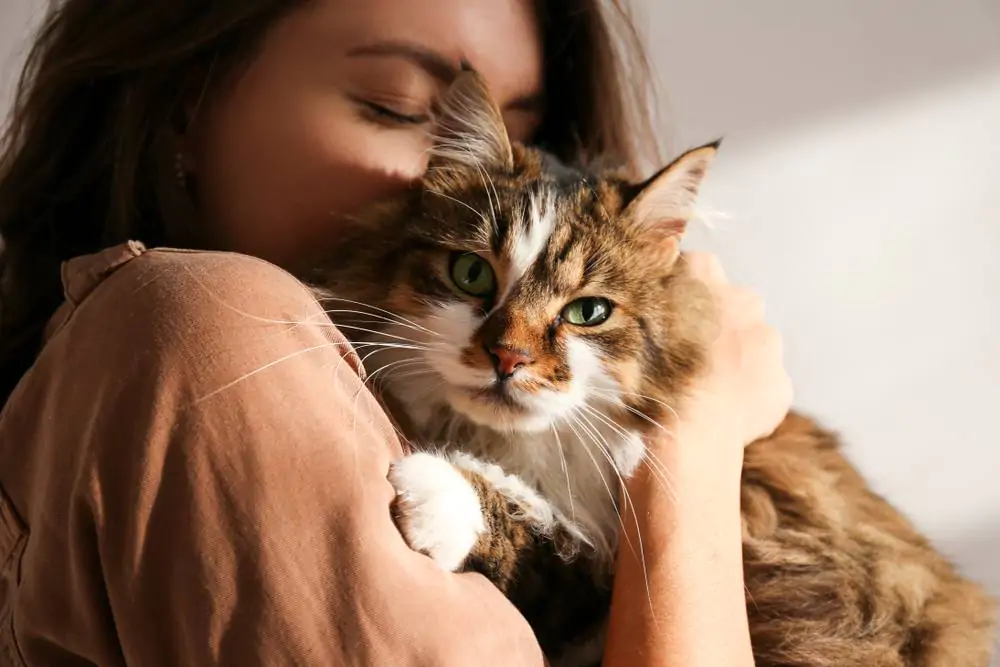Cats are cheeky pets that liven many people’s lives. See our articles about cats examples and prompts if you plan to write about these lovable creatures.
Fiora and Tariq are twin cats I found in a makeshift fire pit at the side of the road when I was walking home from school one day. I heard meowing, saw something wriggling away from the small fire, and took the tiny bag to safety. Two sets of wide, panicked eyes met mine when I opened the bag, and it didn’t take me another second to decide to take these twin cats home, even if it meant facing my father’s wrath.
I had misgivings about nurturing cats, mainly because my experience was limited to a friend’s hissing Himalayan feline that never wanted to be touched. But Fiora and Tariq grew into clingy cats, and now my grandmother has sole custody of the latter.
Cats are adorable pets that don’t need regular bathing or walking. Plus, they help their owners cope with depression. If you want to write about this topic, see our essays about depression.
Contents
- 5 Example Articles
- 1. Domestic Cats and Their Impacts on Biodiversity: A Blind Spot in the Application of Nature Conservation Law by Arie Trouwborst
- 2. Why Do We Think Cats Are Unfriendly? By Stephen Dowling
- 3. Domestic Cat by National Geographic
- 4. Do Hypoallergenic Cats Even Exist? 3 Myths Dispelled About Cat Allergies by Susan Hazel and Julia Henning
- 5. Is It Okay To Let Your Kitten Cry? By Maria Azzurra Volpe
- 6 Prompts for Articles About Cats
5 Example Articles
1. Domestic Cats and Their Impacts on Biodiversity: A Blind Spot in the Application of Nature Conservation Law by Arie Trouwborst
“Notwithstanding this growing awareness of their negative impact on wildlife, domestic cats continue to inhabit a place that is, at best, on the periphery of international wildlife law. No doubt, there are political, sociological and psychological explanations for this regulatory oversight but the implications for wildlife conservation are profound.”
Because domestic cats have a negative impact on wildlife, Trouwborst et al. aim to identify various conservation laws to tackle their effects, including government authorities’ role in preserving wildlife. The authors delve into domestic cats’ impact on people, other species, and ecosystems. They also examine strategies to reduce its adverse effects, including vaccination, immunization, etc.
After reviewing the laws and their application, the researchers concluded two things. First, the government needs to enact and enforce regulations to eliminate, reduce, and prevent the threats posed by domestic cats. Second, the feasibility, scientific uncertainty, and interest of pet cats and owners greatly influence law enforcement.
2. Why Do We Think Cats Are Unfriendly? By Stephen Dowling
“The cat that may be currently curled up on your sofa or glaring at you from its vantage point on top of the bookcase shares many of its instincts with that of its pre-domestic ancestors – the desire to hunt, to patrol territory, guarding it from other cat; they are much closer to their old selves than dogs. Our taming of cats has only partly removed them from the wild.”
Dowling compares clingy cats versus distant ones and notes their body language to identify their mood and emotions. Despite extended training, dogs, humans, and cats are still different and cannot be alike.
He also mentions that cats’ gazes look unfriendly and scary compared to dogs because they don’t have the muscles to look gentle, but their slow, blinking stares express their love. In the end, he advises readers not to be disappointed if their cats don’t greet them. Their behavior of staring is a way to say they’re happy to see their owner.
3. Domestic Cat by National Geographic
“Thousands of years ago, these wildcats were likely drawn to human settlements and their plentiful mice and food scraps. People realized these rodent catchers were helpful to have around, and eventually the two species began living together. Later, people began to bring felines aboard ships as they traveled the world.”
This article dives into the history of how we have domestic cats, where they come from, how they reproduce, etc. According to their research, there are at least 45 domestic cat breeds today, with the Maine Coon being the largest and the Singapura from Singapore being the smallest. The author also notes other interesting information, such as cats mating and having an average of four kittens after 64 days.
Cats communicate with their owners through bunting (rubbing their faces) and swishing their tails. Domestic cats are carnivores, have a strong hunting instinct, and have excellent night vision.
Looking for more? Check out these essays about dogs.
4. Do Hypoallergenic Cats Even Exist? 3 Myths Dispelled About Cat Allergies by Susan Hazel and Julia Henning
“What we do know is that pet cats provide companionship and joy to many, and understanding the causes and treatment of pet allergy can only help both cats and humans.”
In this article, the authors dissect myths linked to hypoallergenic cats, examining their basis and if they are true. The first myth includes people allergic to cat hair and pointing out that it’s not the hair they are hypersensitive to but the substance in it. Second, the authors claim that there isn’t enough evidence for a hypoallergenic cat, only cats with less hair, like the Sphynx. Third, allergic people must give their cats away if it’s a life-threatening allergy, but if it’s just a mild one, there are ways to raise a cat.
5. Is It Okay To Let Your Kitten Cry? By Maria Azzurra Volpe
“… Just like babies, it is their own way of communicating with you. They may cry multiple times a day, for various reasons, and if you’re not a cat expert, it can be really hard to identify what’s behind their discomfort.”
Volpe’s article explains why kittens cry, according to veterinarians. When a kitten calls, they usually have physical needs such as wanting to eat or going to the potty. Crying also means they want their owners’ attention or are experiencing pain and discomfort.
It’s usual for kittens to cry at night, and they shouldn’t be ignored. Volpe includes methods to comfort and stop the kitten from crying and meet their needs, such as providing companionship and training.
6 Prompts for Articles About Cats
1. Cat Care at Home

Dedicate your article to guiding cat owners on how they can care for their pets at home. You can divide your piece depending on where the owner lives, such as a condominium or a house. You can also use this prompt to answer the most basic questions a future cat owner should consider before adopting a cat. Write about cat characteristics, needs, and budget for expenses.
2. Can Aggressive Cats Be Friendly?
In your article, discuss the motives behind a cat’s erratic behaviors and if they can be altered. Present cases where cats become aggressive, and the reason they became this way to encourage patience and empathy. Include effective tips owners can do to handle and calm their cats. Remember to give detailed examples so that readers can follow the steps well.
3. Understanding Your Cat’s Behavior
Cats sometimes bite and scratch people, bring their kills to their owners, knock and cuddle things, meow a lot, and run for no reason. Discuss the meaning of these odd cat behaviors in your article and why they do it. Ensure that you have supporting evidence from science or experts examining cats’ demeanors to assist owners in caring for their pets.
4. How To Keep Your Cat Happy and Healthy
Devote your article to listing care tips every cat owner should know to ensure their cat stays healthy and happy. These pieces of advice should focus on the animal’s well-being and mental state, so they don’t get stressed and pose more problems to the owner. Discuss proper grooming practices, food, vitamins, toys, exercise, etc.
5. The Benefits of Raising a Cat

A small feline friend can be a joy and treasure in many ways. For this prompt, explain why cats are great pets, especially for first-time fur parents. Then, present the scientifically proven health benefits of raising a cat at home. You can also include emotional support cats that comfort their owners with mental health issues.
6. Famous Cats
Create an entertaining article introducing the world’s most popular cats, whether they are real, fictional, or animated cats. Some great examples are Jim Davis’ Garfield, Breakfast at Tiffany’s Orangey, and Shrek’s Puss in Boots. Describe how and why they became famous.
For help editing your articles, we recommend using the best grammar checker. Our round-up profiles these tools and offers discounts.